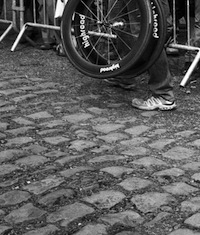 Podium Cafe has been getting some great interviews this off-season. Last week, they published a long conversation with Dutch phenom Martijn Maaskant, and today George Hincapie stepped up to the mic.
Podium Cafe has been getting some great interviews this off-season. Last week, they published a long conversation with Dutch phenom Martijn Maaskant, and today George Hincapie stepped up to the mic.
While the whole interview is a fun read, what really struck me was this bit about Hincapie’s early departure from the ’09 Roubaix:
Last year for instance, when I flatted, I just went to move up in a corner, and I just took a little bit of a risk and got off the crown of the cobbles and went to the side of the road, and sure enough I flatted right there.
So looking back on that moment that was a big mistake because I really didn’t have to move up. We were going really slow and I was in the top ten, top fifteen position, which is totally fine. But in Roubaix there’s always that fine line in being too far back.
Sometimes you’ll miss that split of five guys, and I’m always very conscious of being up there, and I’m usually there when the split goes. But this time I tried to move up at the wrong time in the wrong place and that was the end of my race.
Yeah. I can’t decide which is more telling—that 15th wheel with 80k to go, at a not-crazy pace, wasn’t quite a good enough place to chill out for a moment, or that something as innocuous as riding in a not-perfect spot for a split second at that distance out effectively ended his race.
Man, I can’t wait for April.
George needs to ride Cross, with low pressure so he can learn how not to flat. At least that’s what I’m guessing Myerson would say…
learn how not to flat.
I don’t know where to begin with that statement…. Maybe “Sigh….”?
re ‘learn how not to flat’…
i read an interview recently (prior to the ’09 race) where Tom Boonen commented that being strong isn’t enough in roubaix.
he said you have to ride smart and pick your lines carefully and that in all the editions of roubaix he has raced, he has never flatted.
coincidence?
Might be something to it. Roger DeVlaeminck, who knows his way around Roubaix pretty well, suffered surprisingly few flats during his career.
He also did some weird stuff with his tires, aging them in a basement or something to make the casing less-puncture prone. I’m guessing there’s limited scientific basis for that.
since when is Tom Boonen careful about picking lines 😉
– sorry couldn’t resist. I’d be very happy to see TB win either Flanders or Roubaix, or both, this spring.
The comment about doing something wierd with his tubs (DeVlaeminck).
It’s a regularly practice among pro teams & mechanics,to have a stock of ‘aged’ tubs
Something about the tread (not casing) toughening up with time.
Interesting point that Boonen hasn’t ever flatted.
Last years (which i went to see) was bone dry,& presumably easier to pick your line.wait for the classic mud years,where the riders don’t have a lot of choice about the line they pick,& see if he flats then!
@Anon: Thanks for the clarification on the tires. I also think we’re a few years overdue for some rainy misery at the Hell of the North.
Boonen said himself (I think it was in a procycling interview) something along the lines of: “In the old days we used to age our Roubaix tires in a basement. Now we just put latex in them, it works better.”
Four times winner Roger De Vlaeminck only punctured once in about a dozen rides so it is possible to “learn how not to flat” I have read that he rode tyres at 5 bar for P-R and 6 bar for other events which seems very soft but it worked for him.
Aging (curing tires) was a tradition widely in use up until at least the early 90s; maybe it still happens at the pro level. You’d buy your tires 1+ years in advance and store them in a cool dry place, mounted on rims at medium pressure. The goal was to allow the tread to harden, while the casing stretched evenly, to allow for ease of mounting.
However I recall reading that vulcanized rubber (which all major companies currently use) doesn’t age or cure. So it is probably a tradition mostly for naught. But if it gives riders and the mechanics added confidence…
The purpose of riding the tires at such a low pressure is that you limit suspension losses (while improving comfort) on the pave while not overly increasing rolling resistance on the tarmac. In P-R a Journey Through Hell I read that De Vlaeminck used 8 bar, but that seems rather high